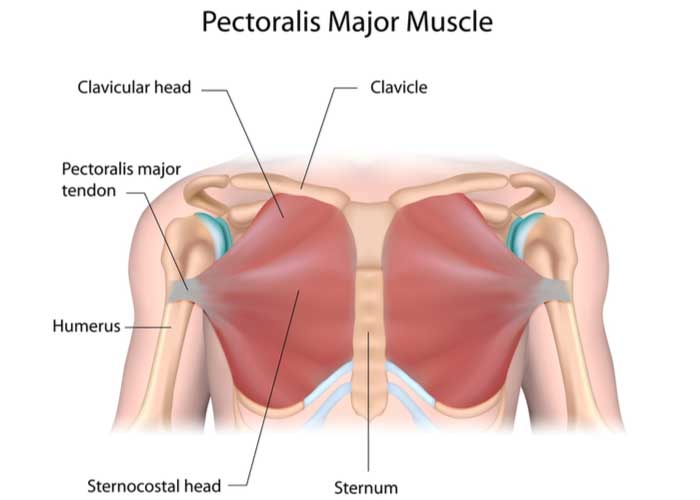Pectoralis Tendon Tear Specialist

Are you an athlete who participates in heavy lifting? If so, you may be at risk of tearing your pectoralis major tendon. A surgical pectoralis major tendon repair is the recommended treatment option in most cases of a pectoral tear but in some cases, surgery may not be required. Pectoralis tendon tear Doctor Riley J. Williams provides diagnosis as well as surgical and nonsurgical treatment options for patients in Manhattan, Brooklyn, New York City and surrounding areas who have sustained a petoral major tendon tear or injury. Contact Dr. Williams’ team today!
What is a pectoralis major tendon tear?
The pectoralis major is the large muscle that sits atop the chest wall. The pectoralis major and pectoralis minor muscles provide strength and stability to the shoulder. The pectoral muscles assist with lifting heavy objects, and in moving the arm forward and backward. The pectoralis major is the larger and more commonly injured muscle; the pectoralis major originates from the center of the chest (sternum) and the collarbone (clavicle) and attaches to the upper arm (humerus) just under the armpit. The pectoralis major tendon is a sturdy collagenous structure that can handle high loads. “Pec” tendon tear occurs when the tendon is pulls away from its attachment on the humerus; such tears often occur with weightlifting or sudden falls onto an outstretched arm. Tendon tears can be partial or complete. Dr. Riley J. Williams, orthopedic shoulder specialist serving patients in Manhattan, Brooklyn, New York City, NY and surrounding areas, has the knowledge and understanding, as well as substantial experience in treating patients who have experienced a partial or complete pectoralis major tendon tear.

What causes a pectoralis major tendon tear?
A pectoralis major tendon injury is often the result of sports-related activities, and most commonly seen among weightlifters. During a process known as eccentric contraction, the muscle fibers are lengthened as an external force is applied to the muscle. Tendon tears occur when the force applied to the pectoralis major muscle surpasses the strength of its attachment to the bone.
What are the types of pectoralis major tendon tears?
Pectoralis major tendon tears are classified into four categories based on the severity of the injury.
Type 1: The pectoralis major tendon is torn from the humerus. This is a common injury and is often surgically repaired.
Type 2: The area where the pectoralis major muscle meets the tendon, the musculotendinous junction, is torn or strained. This is also a common injury and often surgically repaired.
Type 3: The tear has occurred within the pectoralis major muscle belly, and the tendon remains fully intact.
Type 4: The pectoralis major tendon is torn from the sternocostal head.
What are the symptoms of a pectoralis major tendon tear?
The most common complaint of a pectoralis major tendon tear is sudden and severe pain at the time of injury. Other symptoms include:
- A “popping” sound or “snapping” sensation at the time of injury
- Decreased muscle strength, especially with arm movement
- Inflammation and bruising at the tendon attachment site
- Visual deformity of the chest wall muscle (hollow armpit)
How is a pectoralis major tendon tear diagnosed?
Dr. Williams can diagnose a pectoralis major tendon tear with a comprehensive medical history and physical examination. Diagnostic imaging, such as x-rays and magnetic resonance imaging (MRI), may be needed to confirm the injury and to identify damage to other structures within the arm or chest wall.
What is the treatment for a pectoralis major tendon tear?
Non-surgical treatment:
Patients diagnosed with a pectoralis major tendon strain are strongly encouraged to refrain from activities that cause pain or initially caused the injury. The application of ice and non-steroidal anti-inflammatory medications can help to reduce the pain and inflammation associated with this injury. This approach is recommended for muscle-tendon and isolated muscle injuries.
Surgical treatment:
Surgical repair is indicated for patients diagnosed with a complete pectoralis major tendon tear. Repair of this injury is completed by reattaching the injured tendon back to its anatomical insertion on the humerus. Open surgery is needed for a formal pectoralis major tendon repair. A small incision is made at the proximal arm. The tendon is identified and secured back to the humerus using specialized bone anchors. Chronic pectoralis tears may need tissue augmentation as part of the repair procedure; a tendon transplant from the patient (autograft) or a donor (allograft) can be used in these circumstances. During surgical intervention, Dr. Williams will be careful to protect the surrounding neurovascular structures, as well as the biceps tendon and deltoid muscle that lie within close proximity of the injured tendon.
For more information on pectoralis major tendon tears, or the excellent treatment options available, please contact the office of Dr. Riley J. Williams, an orthopedic shoulder specialist serving Manhattan, Brooklyn, New York City, NY and surrounding areas.
